This year, the Colchester Archaeology Trust took on archaeological fieldwork in a whole range of locations, from private back gardens to school grounds, from gravel-extraction quarries to town-centre sites, from agricultural land, within the old garrison at Colchester, and at a great castle keep, through to a borough park, a roadside cable trench, and actually inside buildings, as at the Williams & Griffin store in Colchester, as well as a number of building recording projects. Working primarily in Essex and Suffolk, they specialise in the archaeology of Colchester, which is one of the important archaeological sites in Britain.
Several archaeological highlights this year include The ‘Fenwick treasure’, the hoard of Roman jewellery and coins discovered at the Williams & Griffin store in Colchester which attracted local, national and international interest (http://www.pasthorizonspr.com/index.php/archives/09/2014/colchesters-hidden-roman-treasure).
A range of finds
The burned human bones from the same site, dating to the Boudican revolt and showing evidence of cut injuries, are tragic and fascinating finds. The evidence of centuries of rural life at Brightlingsea, from the prehistoric to the Anglo-Saxon periods, is interesting as well. We also uncovered more information from the site of the high-status Roman temple of Jupiter at St Helena School in Colchester.
Here at Roman Circus House, the reconstructed stumps of the Roman circus starting-gates in the garden next door were completed and acoustic panels and two new screens in the circus centre were installed.
The large circus super-model is nearing completion. The remarkable renovation of the building continued. The circus site and centre were open to visitors until September, when we closed for the winter. We were delighted to be awarded two generous grants to construct a walkway for visitors along part of the site of the circus (by the Hervey Benham Trust and the Essex Heritage Trust).
The Roman circus centre was open to visitors, and for group visits and guided tours. The building has also been used by other groups this year – the Colchester Young Archaeologists’ Club and the Colchester Archaeological Group. We hosted two special events: the WW1 commemorative event in August and a NAAFI day for the national Heritage Open Days in September. Other groups held their own events here. A lot of strange and interesting things are brought back to Roman Circus House, but perhaps the most unusual delivery was the set of some of Colchester’s decommissioned historic street lamps…
The Trust is commissioned by clients to undertake archaeological projects to help them fulfil conditions on their planning applications. The conditions are issued by local authority planning officers in accordance with the legislation. We take commissions through the whole process, from the initial Written Scheme of Investigation, through fieldwork and post-excavation to the final report. We also undertake projects in advance of planning applications, such as consultancy, heritage statements, and desktop studies and assessments. After the completion of every project, our reports all become part of the national archaeological record, and finds and archaeological material are deposited with the museum which is local to the site. The Trust employs a team of archaeologists and we are assisted by a team of dedicated archaeology volunteers and renovation volunteers.
All reports on fieldwork projects are published in this online archive at http://cat.essex.ac.uk/ .
CAT wishes to thank to all clients, colleagues, volunteers and visitors.
Source: Colchester Archaeology Trust



